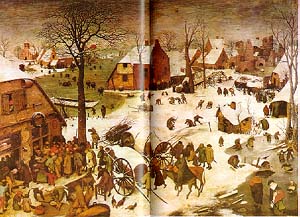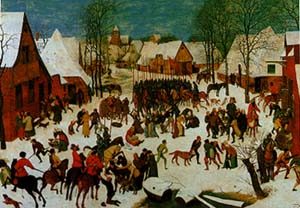W.H.Auden
(1907-1973)
Wystan Hugh Auden was born in York, England, in 1907. He moved to Birmingham during childhood and was educated at Christ Church, Oxford. As a young man he was influenced by the poetry of Thomas Hardy andRobert Frost, as well as William Blake, Emily Dickinson, Gerard Manley Hopkins, and Old English verse. At Oxford his precocity as a poet was immediately apparent, and he formed lifelong friendships with two fellow writers, Stephen Spenderand Christopher Isherwood.
In 1928, his collection Poems was privately printed, but it wasn't until 1930, when another collection titled Poems (though its contents were different) was published, that Auden was established as the leading voice of a new generation.
Ever since, he has been admired for his unsurpassed technical virtuosity and an ability to write poems in nearly every imaginable verse form; the incorporation in his work of popular culture, current events, and vernacular speech; and also for the vast range of his intellect, which drew easily from an extraordinary variety of literatures, art forms, social and political theories, and scientific and technical information. He had a remarkable wit, and often mimicked the writing styles of other poets such as Dickinson, W. B. Yeats, and Henry James. His poetry frequently recounts, literally or metaphorically, a journey or quest, and his travels provided rich material for his verse.
He visited Germany, Iceland, and China, served in the Spanish Civil war, and in 1939 moved to the United States, where he met his lover, Chester Kallman, and became an American citizen. His own beliefs changed radically between his youthful career in England, when he was an ardent advocate of socialism and Freudian psychoanalysis, and his later phase in America, when his central preoccupation became Christianity and the theology of modern Protestant theologians. A prolific writer, Auden was also a noted playwright, librettist, editor, and essayist. Generally considered the greatest English poet of the twentieth century, his work has exerted a major influence on succeeding generations of poets on both sides of the Atlantic.
W. H. Auden was a Chancellor of The Academy of American Poets from 1954 to 1973, and divided most of the second half of his life between residences in New York City and Austria. He died in Vienna in 1973.
A Selected Bibliography
Poetry
Poems (privately printed, 1928)
Poems (1930)
The Orators prose and verse (1932)
Look, Stranger! in America: On This Island (1936)
Spain (1937)
Another Time (1940)
The Double Man (1941)
The Quest (1941)
For the Time Being (1944)
The Sea and the Mirror (1944)
Collected Poetry (1945)
The Age of Anxiety: A Baroque Eclogue (1947)
Collected Shorter Poems 1930-1944 (1950)
Nones (1952)
The Shield of Achilles (1955)
Selected Poetry (1956)
The Old Man's Road (1956)
Homage to Clio (1960)
About the House About the House (1965)
Collected Shorter Poems 1927-1957 (1966)
Collected Longer Poems (1968)
City without Walls (1969)
Academic Graffiti (1971)
Epistle to a Godson (1972)
Thank You, Fog: Last Poems (1974)
Selected Poems (1979)
Collected Poems (1991)
Poems (1930)
The Orators prose and verse (1932)
Look, Stranger! in America: On This Island (1936)
Spain (1937)
Another Time (1940)
The Double Man (1941)
The Quest (1941)
For the Time Being (1944)
The Sea and the Mirror (1944)
Collected Poetry (1945)
The Age of Anxiety: A Baroque Eclogue (1947)
Collected Shorter Poems 1930-1944 (1950)
Nones (1952)
The Shield of Achilles (1955)
Selected Poetry (1956)
The Old Man's Road (1956)
Homage to Clio (1960)
About the House About the House (1965)
Collected Shorter Poems 1927-1957 (1966)
Collected Longer Poems (1968)
City without Walls (1969)
Academic Graffiti (1971)
Epistle to a Godson (1972)
Thank You, Fog: Last Poems (1974)
Selected Poems (1979)
Collected Poems (1991)
Prose
Letters from Iceland (1937)
Journey to a War (1939)
Enchaféd Flood (1950)
The Dyer's Hand (1962)
Selected Essays (1964)
Forewords and Afterwords (1973)
Journey to a War (1939)
Enchaféd Flood (1950)
The Dyer's Hand (1962)
Selected Essays (1964)
Forewords and Afterwords (1973)
Anthology
Selected Poems by Gunnar Ekelöf (1972)
Drama
Paid On Both Sides (1928)
The Dance of Death (1933)
The Dog Beneath the Skin: or, Where is Francis? (1935)
The Ascent of F.6 (1936)
On the Frontier (1938)
The Dance of Death (1933)
The Dog Beneath the Skin: or, Where is Francis? (1935)
The Ascent of F.6 (1936)
On the Frontier (1938)
Listen to the poem "Musee des Beaux Arts"
About the poem:
Paintings with Biblical allusions:
 |
"[Bruegel] depicted a Flemish village on a cold December evening; the red ball of the setting sun has begun to slip behind the trees at the left. Peasants trudge through the ice and snow from all directions, converging on the inn at lower left, where a crowd has already gathered to pay its taxes. Amid the bustle, no one notices the presence of Joseph leading the Virgin on a mule." (144)

Questions for Understanding and Analysis
- This poem by Auden seems to allude to three paintings. Of the three paintings reproduced above, which painting do lines 5-8 refer to? Which painting do lines 9-13 refer to? Which painting do the remaining lines refer to? How do the first four lines relate to all three of these paintings?
- Briefly, what is the mythological story about Icarus? What part of that story is expressed in Breughel's painting about Icarus?
- Both the first and the second stanzas are about the position of human suffering in life, or the concurrence of grand human suffering and the daily (and sometimes trivial) activities. (The "its" and "it" in line 3 refers to human suffering and aspiration.)
- a. What are the examples of human suffering in the first stanza? How are they set in contrast to the daily activities of human beings or even animals? For the speaker, these two kinds of events concur and the "Old Masters" know it. What is the speaker's attitude toward this concurrence, and toward the Old Master? (Pay special attention to the depiction of the children, the dogs, and the horse.)
- b. The human suffering in the second stanza is Icarus's failed aspiration. But in this stanza, as well as in Brueghel's painting, the focus is not so much on Icarus' aspiration/suffering (his "forsaken cry" and disappearing "white legs") as on the plowman's, the sun's and the ship's indifference to it. Why? And what do the speaker of the poem and the painter think about this indifference?
- When you first read this poem, you probably did not notice the rhymes. Go back over the poem now and identify the rhyming words. How do these almost hidden rhymes relate to the meaning of the poem? Do they suggest something about the possibility for order in a world that appears disorderly?
- Do you see other patterns of order in the poem?
- What do the poem and paintings suggest about art and nature?
- How would "Musée des Beaux Arts" be different if the speaker let us know more about his own thoughts and feelings?
- Is this a poem about Icarus's flight? Or about something else? (Put another way, who's the main character in this poem?
- Why is the title important?
.jpg)
Комментариев нет:
Отправить комментарий